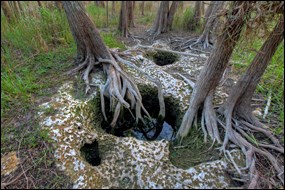
NPS photo Large areas of freshwater marl prairie border the deeper sloughs of the Everglades. These relatively short-hydroperiod marshes are typified by a diverse assemblage of low-growing vegetation. A complex mixture of algae, bacteria, microbes, and detritus that is attached to submerged surfaces, periphyton serves as an important food source for invertebrates, tadpoles, and some fish. Periphyton is conspicuous and is the basis for the marl soils present. The marl allows slow seepage of the water but not rapid drainage. Though the sawgrass is not as tall and the water is not as deep, freshwater marl prairies look a lot like freshwater sloughs. 
NPS photo by G. Gardner Marl prairie occurs on thin, calcitic soil that has accumulated over limestone bedrock. In places, the bedrock may be exposed as jagged, foot-tall projections called pinnacle rock, or it may be dissolved below the surface of the ground into solution holes. Most precipitation is of relatively neutral pH, but it becomes increasingly acidic as it infiltrates live plant tissue, decaying plant debris, and soils before seeping into the ground. The acidic water dissolves the carbonate rock along cracks and fractures in the bedrock. Over thousands of years, dissolution within pore spaces and along fractures creates increasingly larger voids. |
Last updated: August 6, 2015
